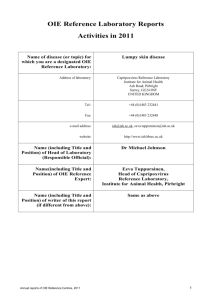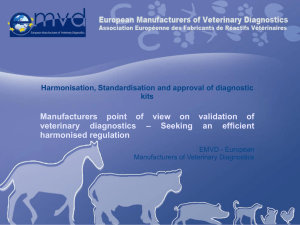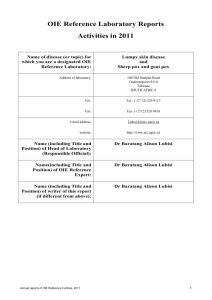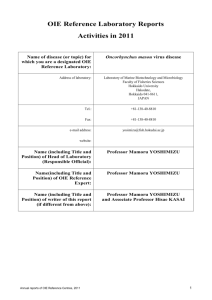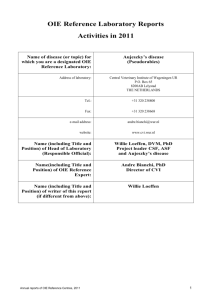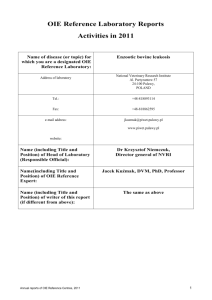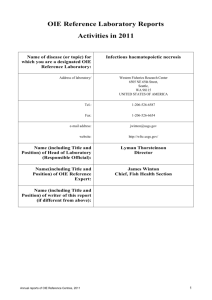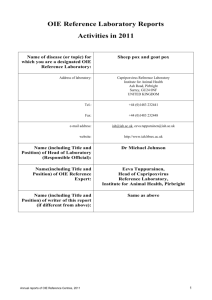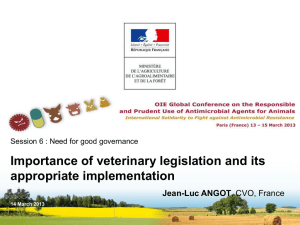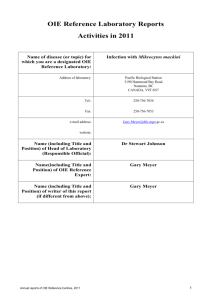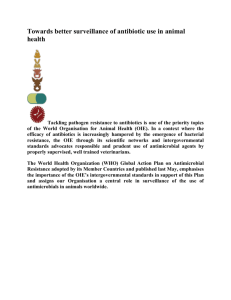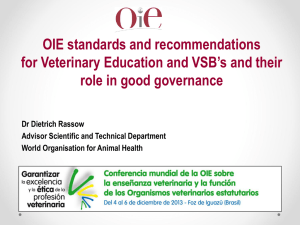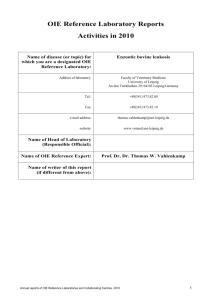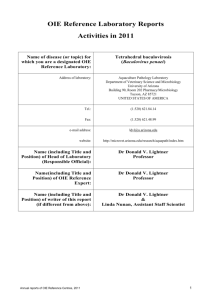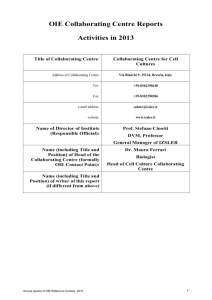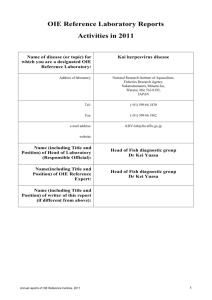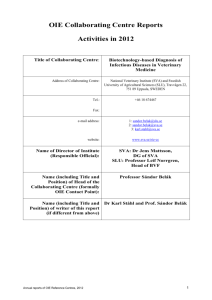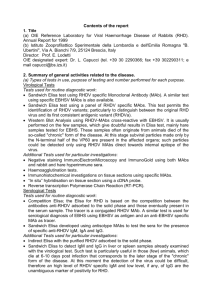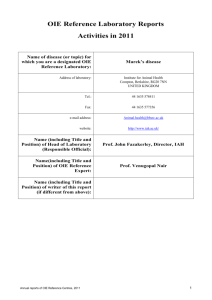PCR - OIE
advertisement
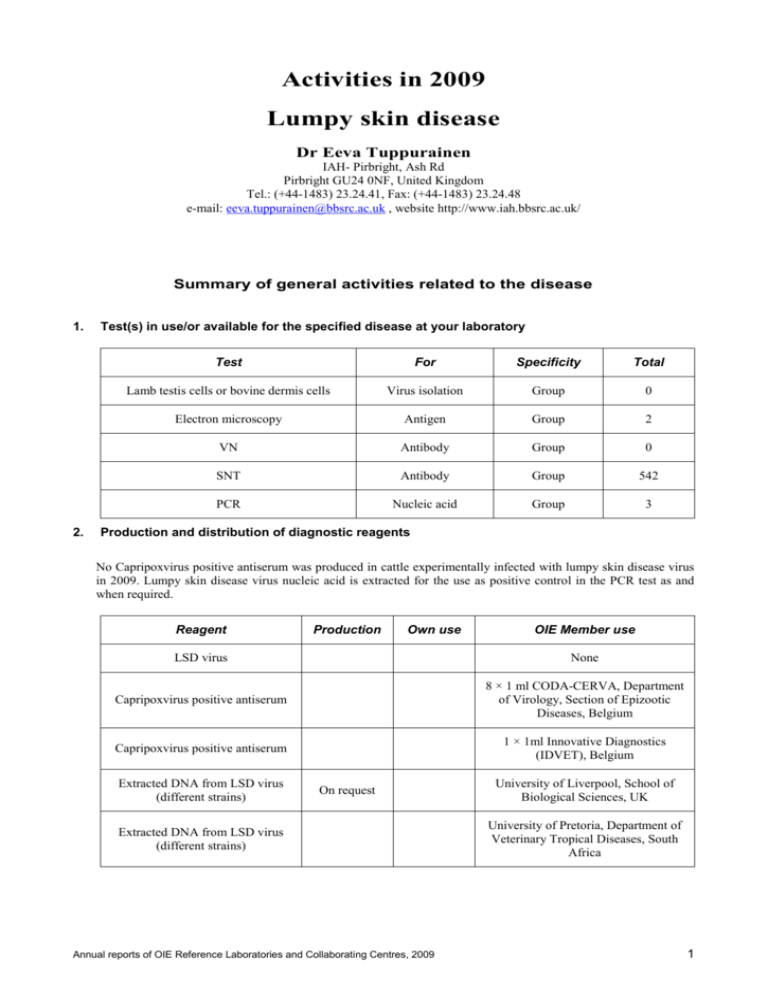
Activities in 2009 Lumpy skin disease Dr Eeva Tuppurainen IAH- Pirbright, Ash Rd Pirbright GU24 0NF, United Kingdom Tel.: (+44-1483) 23.24.41, Fax: (+44-1483) 23.24.48 e-mail: eeva.tuppurainen@bbsrc.ac.uk , website http://www.iah.bbsrc.ac.uk/ Summary of general activities related to the disease 1. 2. Test(s) in use/or available for the specified disease at your laboratory Test For Specificity Total Lamb testis cells or bovine dermis cells Virus isolation Group 0 Electron microscopy Antigen Group 2 VN Antibody Group 0 SNT Antibody Group 542 PCR Nucleic acid Group 3 Production and distribution of diagnostic reagents No Capripoxvirus positive antiserum was produced in cattle experimentally infected with lumpy skin disease virus in 2009. Lumpy skin disease virus nucleic acid is extracted for the use as positive control in the PCR test as and when required. Reagent Production Own use OIE Member use LSD virus None Capripoxvirus positive antiserum 8 × 1 ml CODA-CERVA, Department of Virology, Section of Epizootic Diseases, Belgium Capripoxvirus positive antiserum 1 × 1ml Innovative Diagnostics (IDVET), Belgium Extracted DNA from LSD virus (different strains) On request Extracted DNA from LSD virus (different strains) Annual reports of OIE Reference Laboratories and Collaborating Centres, 2009 University of Liverpool, School of Biological Sciences, UK University of Pretoria, Department of Veterinary Tropical Diseases, South Africa 1 Lumpy skin disease Activities specifically related to the mandate of OIE Reference Laboratories 3. International harmonisation and standardisation of methods for diagnostic testing or the production and testing of vaccines The following institutes were provided with LSD-positive antiserum for setting up serological tests for the detection of Capripoxvirus antibodies: CODA-CERVA, Department of General Virology, Section of Epizootic Diseases, Belgium and Innovative Diagnostics (IDVET), Belgium Veterinary Research Centre, Ministry of Agriculture, Sultanate of Oman was provided with a method sheet for the PCR test which is currently used in the Capripoxvirus Reference Laboratory at IAH for the detection Capripoxvirus antigen. The following institutes/countries sent participants to attend a training course (20.04-24.4.09) entitled, “Diagnostic methods for the detection of Capripox virus antigen or antibody”, prepared and given by Capripoxvirus Reference Laboratory IAH: Jordan Bio-Industries Center (JOVAC), Jordan 4. Preparation and supply of international reference standards for diagnostic tests or vaccines No international standard reagents available. 5. Research and development of new procedures for diagnosis and control Diagnosis A collaborative project « The evaluation of the performance characteristics (specificity and sensitivity) of a recombinant antigen enzyme-linked immunosorbent assay (ELISA) for the detection of antibodies against Capripoxviruses in cattle, sheep and goats (Bowden et.al. 2009) by comparison with the “gold standard” serum neutralisation test (SNT) » was initiated between CSIRO Livestock Industries (CLI)/ Australian Animal Health Laboratory (AAHL), Canadian Food Inspection Agency (CFIA)/ National Centre for Foreign Animal Diseases (NCFAD), Roslin Institute, Royal (Dick) School of Veterinary Studies, Roslin/Genetics and Genomics Division and the Institute for Animal Health/ Capripoxvirus Reference Laboratory, A collaborative project on the comparison of the performance characteristics (specificity and sensitivity) of two realtime polymerase chain reaction (PCR) methods for Capripoxviruses was initiated between FADDL-APHISUSDA/Plum Island Animal Disease Center, USA and the Institute for Animal Health/ Capripoxvirus Reference Laboratory. 6. Collection, analysis and dissemination of epizootiological data relevant to international disease control The Capripoxvirus Reference Laboratory (IAH), and Roslin Institute, Royal (Dick) School of Veterinary Studies, Roslin/Genetics and Genomics Division, are collaborating on retrospective epidemiological studies on the distribution of lumpy skin disease in Cameroon cattle and the influence of different climatic, environmental and farm management variables on the occurrence of the disease. The testing of the samples has been completed and a publication on the results is in progress. 7. Provision of consultant expertise to OIE or to OIE Members The Manual of Diagnostic Methods and Vaccines for Terrestrial Animals/ Lumpy skin disease -chapter (2.4.14) website and LSD -disease card have been reviewed. The Veterinary Research Centre, Ministry of Agriculture, Sultanate of Oman was provided with a method sheet for the PCR test which can be used for the detection of all the members of Capripoxvirus -genus 2 Annual reports of OIE Reference Laboratories and Collaborating Centres, 2009 Lumpy skin disease 8. Provision of scientific and technical training to personnel from other OIE Members A training course on diagnostic methods for the detection of Capripox virus antigen or antibodies was held on 20.04-24.4.09. The following institutes/countries sent participants to attend a training course: Jordan. A Notifiable Diseases Refresher Training; 2 Day Course for UK State veterinarians is required by DEFRA – A presentation giving a general overview on sheep pox, goat pox and lumpy skin disease was provided on 11.06.09. 9. Provision of diagnostic testing facilities to other OIE Members For Senegal and Oman, confirmatory testing (PCR, electron microscopy) 10. Organisation of international scientific meetings on behalf of OIE or other international bodies No activity during this reporting period 11. Participation in international scientific collaborative studies Ongoing research projects: A collaborative project on retrospective epidemiological studies on the distribution of lumpy skin disease in Cameroon cattle and the influence of different climatic, environmental and farm management variables on the occurrence of the disease between Roslin Institute, Royal (Dick) School of Veterinary Studies, Roslin/Genetics and Genomics Division and the Institute for Animal Health/ Capripoxvirus Reference Laboratory has been undertaken. The testing of the samples has now been completed and the results will be published in a peer-reviewed journal. A pilot study on the transmission of lumpy skin disease virus by Ixodid tick vectors was undertaken in collaboration with the Department of Veterinary Tropical Diseases, Faculty of Veterinary Science, University of Pretoria and the Onderstepoort Veterinary Institute (OVI) South Africa. The work has now been completed and the results will be published in a peer-reviewed journal. Further funding for 3 years has been obtained via a CIDLID grant to continue this work. A collaborative study with the University of Liverpool on the molecular characterization of 3 lumpy skin disease virus isolates from the Middle East region is on-going. The isolates have been sequenced, the data will be analyzed and the results will be published in a peer-reviewed journal. The head of the Capripoxvirus Reference Laboratory will lead the Capripoxvirus Expert Group in the EU FP7 DISCONTOOLS project. The aim of this project is to build a detailed database on internationally important animal diseases on a public website, based on the input of the Expert Groups. The database will enable detailed comparisons of these data. Links will be built to the important database by the EMIDA ERA-Net which will allow one to explore what work has been done on a particular disease, what work is ongoing and where expertise in relation to a particular disease is based. 12. Publication and dissemination of information relevant to the work of OIE (including list of scientific publications, internet publishing activities, presentations at international conferences) Presentations at international conferences and meetings Tuppurainen ESM., Stoltsz H., Troskie M., Wallace D., Oura C., Mellor P.S., Coetzer J.A.W. and Venter E.H. (2009). Transmission of LSDV by hard (Ixodid) ticks. XIII International Congress on Veterinary Virology, European Society of Veterinary Virology. Budapest, Hungary, 23 – 26 August 2009. Scientific publications in peer-reviewed journals Le Goff, C., Lamien, C.E., Fakhfakh, E., Chadeyras, A., Aba-Adulugbad E., Libeau G., Tuppurainen E., Wallace D., Adam T., Silber R., Gulyaz V., Madani H., Caufour P., Hamammi S., Diallo A. & Emmanuel Albina (2009). Annual reports of OIE Reference Laboratories and Collaborating Centres, 2009 3 Lumpy skin disease Capripoxvirus G-protein-coupled chemokine receptor, a host-range gene suitable for virus-animal origin discrimination. Journal of General Virology, 90, 67-1977. Other communications EPIZONE website, lumpy skin disease draft pages reviewed 13. Inscription of diagnostic kits on the OIE Register i) Did you participate in expert panels for the validation of candidate kits for inscription on the OIE Register? If yes, for which kits? N/A ii) Did you submit to the OIE candidate kits for inscription on the OIE Register? If yes, for which kits? N/A _______________ 4 Annual reports of OIE Reference Laboratories and Collaborating Centres, 2009
